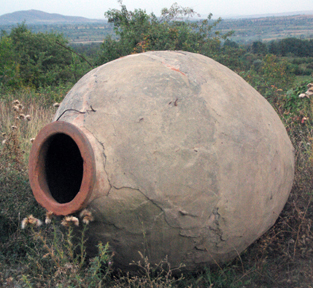 Some people, especially when they first taste a qvevri wine, think they are tasting the qvevri. This is similar to tasting what an oak barrel imparts to the wine if aged. However unlike other vessels for fermenting and aging wines, qvevri do not impart aromas and tastes to the wine. Why not?
Some people, especially when they first taste a qvevri wine, think they are tasting the qvevri. This is similar to tasting what an oak barrel imparts to the wine if aged. However unlike other vessels for fermenting and aging wines, qvevri do not impart aromas and tastes to the wine. Why not?
After the qvevri is fired, it begins to cool down. When it reaches 70ºC (150ºF) melted beeswax is spread throughout the inside of the qvevri. The beeswax is absorbed into the pours of the qvevri and acts to seal the surface. The beeswax also has the property of killing any bacteria that may be present. During fermentation and aging, the wine does not pick up any aromas or tastes from the qvevri.
We asked if this beeswax technology would work with other winemaking vessels. Answers were mixed. However, most think it would not. A qvevri needs to be at the 70ºC stage in order to get optimal absorption of the beeswax. I wondered about the cement vats we saw earlier in France. These vats were either coated with epoxy or left untreated. In either case there is some imparting of aromas or tastes to the wines, although imperceptible to many.
Why do some qvevri wine tasters think they taste the qvevri? They are actually smelling and tasting the effect of fermenting the juice on its chacha (grape skins, seeds and sometimes stems). These items add flavor and aromas to the wines. Although red wines traditionally are fermented on the grapes’ skins, seeds and perhaps stems, it is the white wines that surprise people. Many qvevri white wines are gold to dark amber in color. They have mild tannins to bold tannins. This surprises people that have a notion of what a white wine should look, smell and taste like. If you have an opportunity to taste a qvevri made wine, taste a natural wine that has picked up aromas and tastes from the entire grape, not the qvevri.
Cheers,
Terry



Leave a Reply